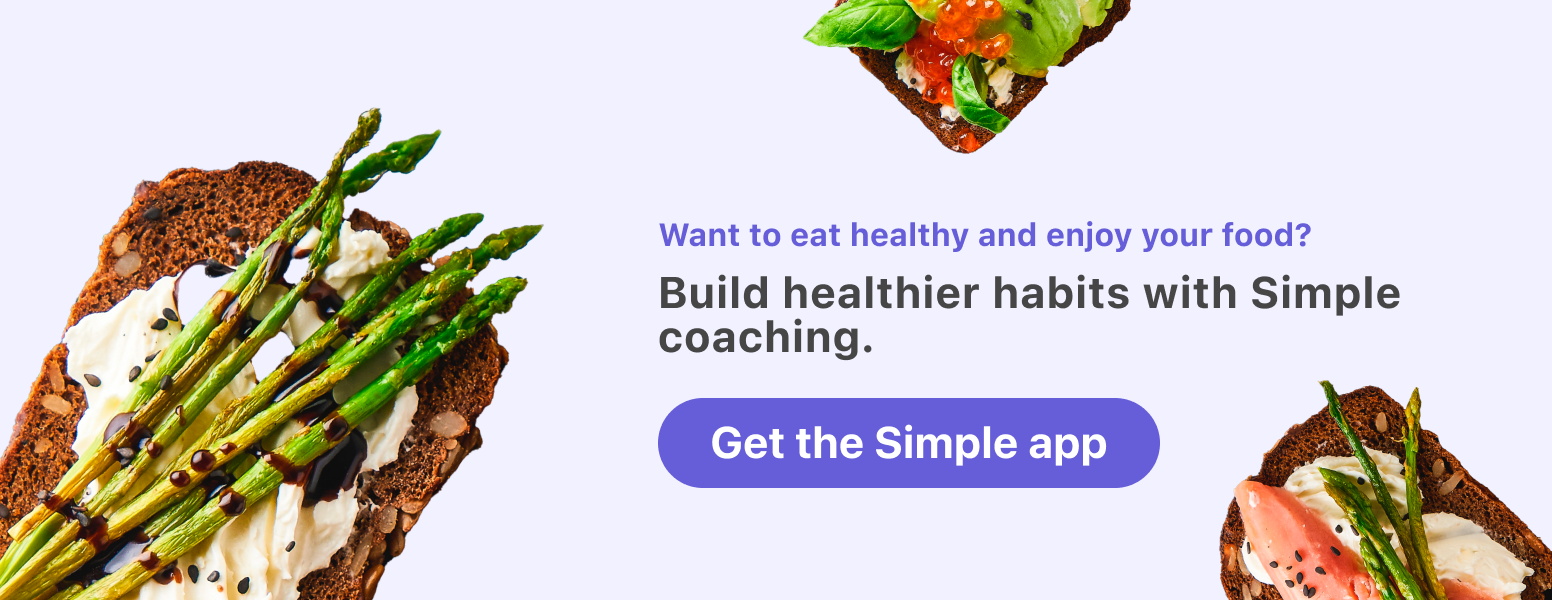The ultimate guide to intermittent fasting 20:4

When we’re trying to lose weight, we usually think about what we can and can’t eat. Bye-bye beer and burgers. Helloooo carrots and kale!
But with intermittent fasting, the focus is on when you can and can’t eat.

20:4 intermittent fasting comes in hot with a 20-hour — yes, a 20-HOUR — fast and a 4-hour eating window.
It sounds a little extreme, huh?
So … does it work?
Is it necessary to fast that long in order to lose weight or improve your health?
Is it even healthy to go 20 hours a day without eating?
Let’s get some answers.
What is intermittent fasting 20:4?
Intermittent fasting 20:4 is a time-restricted eating (TRE) fasting schedule.
It’s not a diet, per se, but it is one of the more extreme kinds of intermittent fasting.
As such, it’s one you will want to work up to, having started out in the shorter TRE zone with a 12-, 14-, or 16-hour fast. We always recommend talking with your healthcare team before making any significant changes to your eating habits, but it’s especially important to run things by them before you attempt this schedule since it involves fasting for 20 hours.
There is a version of the 20:4 intermittent fasting schedule that’s known as the Warrior Diet. In that version, there are three weekly phases of implementation and a small selection of foods allowed during the fasting period.
But intermittent fasting on a 20:4 split can just be a straight-up fast where, during your fasting window, you consume nuthin’ but calorie-free drinks.
For a full rundown of all the drinks that get the Simple green light for being fast friendly, check out our what can you drink when fasting 101.

How is the 20:4 schedule different from the 16:8 schedule?
The most obvious difference is the key one: Four more hours to eat! 16:8 intermittent fasting is a 16-hour fast with an 8-hour eating window.
The main difference between the two will be in how you experience both the fasting and eating windows.
- A 16-hour fast may be less disruptive to your life. Eight hours gives you a fairly normal eating pattern, which could jive more easily with those around you who are not fasting.
- There may be less difference in hunger than you think. Ketones suppress appetite, so if you get into ketosis around or before the 16-hour mark, you might ride out those last few hours all the way to 20 just fine.
- With 20:4 fasting, you’ll need to pay closer attention to what you eat. With four fewer hours to eat, it’ll be a task to make sure your diet includes all the nutrition you need to feel good and function well.
- You can fast overnight with both. 16:8 means you’ll get to break your fast earlier, but you can use the momentum of the overnight fast in both cases.
- There’s far more research on 16:8. There’s no getting around it: the evidence that relates specifically to 20:4 isn’t exactly bursting out of the laboratory filing cabinets.
- You’ll experience more ketosis on 20:4. It stands to reason: a longer fast means your body will have to dive deeper into your fat stores for energy. (Whether this equals speedier results is not quite so clear-cut; there’s not actually really much evidence to suggest more restrictive fasts and better results-wise.)
So which one will work better for you? 16:8 or 20:4?
Well, in true nutrition science style, that depends.
Maybe 16:8 works best because it helps you snack less at night, but 20:4 makes your cravings go so bonkers you can’t help but break your fast with Ben and Jerry’s.
Or, 20:4 works like a dream because you get so laser-focused on your diet that your food choices RULE.
Ultimately, the best results will come from the method that
- you can stick to
- helps you kick your dietary and exercise habits into the next gear
- supports your overall health and well-being (and gets that doctor seal of approval)
So, how does intermittent fasting 20:4 work?

Just like other TRE intermittent fasting methods, you can tailor 20:4 to suit you.
Want to eat from 2 PM to 6 PM, then fast till 2 PM the next day because that fits your work schedule best? No problem!
Prefer to eat between 8 AM and 12 PM to give you ample energy to do your workout and then clear the decks of any food-related needs right through till bed? Go right ahead!
How to start intermittent fasting 20:4
If your healthcare team is on board with the concept, you could jump right in … but we recommend doing some planning to ensure you’ll have the best chance of success.
Your doctor and/or registered dietitian is your best resource since they have both the general expertise and the knowledge of your unique body, but here are some factors to consider.
How to find the best window for you
How you choose to work 20:4 into your life will depend on your lifestyle and routine.
You can mix it up day to day if you choose, too. So long as you hit your 20 consecutive hours of fasting, you can spin this however you like.
And you don’t even have to do it every day. Sure, traditionally, TRE methods of intermittent fasting are intended to be done daily, but you get to decide what works best for your life.
So, to get started, consider:
- When’s the best eating window for you? For instance, when do you need energy the most — for workouts, maybe?
- When’s the best fasting window for you? For instance, when would it help you to not have to think about or break for food?
- When are you most or least hungry naturally? Can you take advantage of your natural cycles? For instance, if you’re not hungry in the morning, include that in your fasting window. And if you’d rather eat your pillow than go to bed hungry, maybe a later eating window might suit you too.
We recommend you start with a shorter fast, then work up. Again, as long as your healthcare team is OK with it, you could leap right in to 20:4. But most people find it easier to practice with shorter fasts and test the waters first. So, consider a 14:10, then a 16:8, then a 17/7 … you get the idea.
Another question to consider: How will you break your fast with relatively health-promoting options? You’ll probably be hungry at the end of 20 hours … so what’s on your menu?
Let’s look at that now.
What to eat on an intermittent fasting 20:4 meal plan
What would a 20:4 intermittent fasting meal plan look like?
Well, what to eat during intermittent fasting is up to you, so think about your goals. What’s your reason for doing 20:4?
Whether it’s something body composition-related (like fat loss or muscle gain) or health improvement-focused (like lowering blood pressure or cholesterol), some foods will support your goals more than others.
Build your diet around:
- lean protein, like fish, beans, turkey, and tofu
- whole grains, like oats, barley, and quinoa
- vegetables and fruits
- calcium-rich foods, like yogurt, cheese, and calcium-fortified almond milk
- healthy fats, like avocados, eggs, and nuts
Here are some sample ideas.
Sample early window
7 AM: Meal 1
Scrambled eggs or tofu and veggie stir-fry:
- tofu and/or eggs for lean protein
- mixed vegetables (e.g., bell peppers, spinach, tomatoes)
Whole grain porridge:
- steel-cut oats, quinoa, or other whole grains
- topped with fruit and nuts
8:30 AM Snack
- fruit smoothie with protein (e.g., protein powder, Greek yogurt, etc.)
10:30 AM: Meal 2
Smoked salmon toast
- smoked salmon on whole grain bread with avocado, tomato, and cucumber
Sample midday window
11 AM Meal 1
Grilled protein bowl
- grilled protein of choice (e.g., salmon, chicken, turkey, beef, tofu, etc.)
- whole grains (e.g., brown rice, quinoa)
- chopped veggies (e.g., broccoli, carrots, and bell peppers)
- avocado topper
12:30 PM Snack
- veggies and hummus with boiled egg(s)
2:30 PM Meal 2
High-protein fruit bowl
- Greek yogurt or cottage cheese
- mixed fruit
- chopped nuts on top
Sample evening window
5 PM Meal 1
Grilled protein and veggie pasta
- grilled protein of choice (e.g., shrimp, chicken, etc.)
- whole grain pasta
- veggies (e.g., tomatoes, peppers, zucchini, etc.)
6:30 PM Snack
- black bean and avocado dip with veggies
8:30 PM Meal 2
High-protein tacos
- protein of choice (e.g., tofu, beef, fish, etc.)
- shredded cabbage, carrots, and tomatoes
- corn or whole wheat tortillas
How can I implement this meal plan?
We know this can sound like a tall order if you’re not used to eating foods like this. Here are three things to help you out:
- Learn how to meal plan
It’s no secret that we’re big fans of meal planning here at Simple. Having a solid plan in place can really help you eat more of the foods you want to eat. Make sure to run it by your healthcare team to ensure it will give you everything you need to feel your best.
- Focus more on what TO eat and less on what NOT to eat
Getting more health-promoting foods into your diet will naturally push out the less health-promoting foods. Plus, it’s more psychologically satisfying (and motivating) to focus on doing than not doing.
- Get personalized feedback by logging your food on the Simple app
All you need to do is take our Simple quiz, and we’ll get you all set up!
Of course, keep your eating for your eating window. During your fasts, stick to calorie-free drinks like tea without milk or sugar, black coffee, and water.
The two versions of 20:4: Warrior or clean?
While we strongly recommend you do your best to include some nutrient-rich, health-promoting foods, some advocates of 20:4 are a little looser in their guidelines.
- The Warrior Diet: This version of the 20:4 isn’t a true fast. Rather, the idea is to eat lightly and sparingly during the day (e.g., with little bites like raw fruits and vegetables, a bit of yogurt, a hard-boiled egg, etc.) The four hours is the feast time when you can eat whatever you want.
- The clean version: This one emphasizes fasting completely during the 20 hours, just like a regular intermittent fast with an extra-long fasting window. So during those 20 hours, it’s water, herbal tea, and black coffee … and that’s it until that magical four hours of feasting.

Intermittent fasting 20:4 and weight loss
There is evidence that suggests intermittent fasting can help people lose weight.[1,2]
That said, the evidence on 20:4 intermittent fasting’s ability to create results for weight loss is very limited.
Any conclusions we draw here, then, will be about the general practice of intermittent fasting.
What can we say with relative confidence?
For many people, intermittent fasting is a simpler way to trim their food intake to lose weight than conventional “dieting.”[2] And, with 20:4, there’s less time to eat, so most people end up eating less overall.
Restricting your calories to a 4-hour window will — almost definitely — cause you to eat fewer calories. As long as you continue to live an active life, that will likely lead to the caloric deficit needed to lose weight.
There’s also a shift in fuel use: our body shifts to using mainly stored body fat for fuel after several hours without food. This is known as ketosis.
Since ketosis really gets into full swing around the 20-hour mark,[3] this may be a good trade-off between even longer fasting windows (which have more downsides) and getting the benefits of ketosis.
However, 20 hours is still a long time to go without food, and there’s still not much evidence to suggest it’s “better” than less restrictive TRE schedules.
Can you exercise on intermittent fasting 20:4?
You can exercise on intermittent fasting 20:4, but there are some things to pay attention to here.
- Make sure to hydrate well
Intermittent fasting — because of a lower food intake — can leave you dehydrated, which is bad news at the best of times. Exercising only increases that risk, so drink lots of water.
- Time your workouts with your eating window
If training fasted works for you, great. Feel free to ignore this tip. But if working out on an empty stomach makes you feel all floppy and weak, pair your workouts with a time when you’re fed.
- Listen to your body
If you feel strong and able to push yourself, do it. If you feel OK but kinda sore and tired, take it easier. If you are in full-on zombie mode and can barely scoot your butt off the couch without falling over, take a rest day (or get some sleep).
We talk more about how to stay safe while intermittent fasting and working out here. It’s also another good topic to raise with your healthcare team!
Intermittent fasting 20:4 diet results
Intermittent fasting — on all schedules, not just 20:4 — has led to some impressive results for Simple members.
Like Solome, who had this to say:
Losing 39 pounds in one year is an incredible result!
Of course, results do vary. What could you achieve?
Health benefits of intermittent fasting 20:4
Current intermittent fasting science doesn’t specifically extend to the benefits of intermittent fasting 20:4. It hasn’t been well studied at this point. As such, the benefits below relate to intermittent fasting more generally.[4,5]
Lower risk of diabetes
Intermittent fasting is often associated with improving blood sugar control and insulin sensitivity. Again, a longer period of lower insulin — since there’s no food coming in for insulin to respond to — may be helpful here.[4,6]
Decreased inflammation
Some studies link intermittent fasting to decreased inflammation in the body, which can reduce the likelihood of inflammatory diseases like heart disease.[7–9]
Better brain health
It’s possible that intermittent fasting could improve your cognition and make your brain better at thinking, learning, and making connections.[10–12]
Health risks of intermittent fasting 20:4
And now, the risks.
Disordered eating
Strict rules around eating can promote disordered eating behaviors like having your thoughts consumed by dieting or binging.[13]
20:4 fasting can have this effect (as can all fasting).
If you’re experiencing this, know that you’re not alone, and it’s OK to stop and get help.
Brain fog
Brains like — and need — food![14]
A 20-hour fast could prevent your thinky brain from doing its best work, though this should resolve once your body has adapted.
Nutrient deficiencies
Eating your daily food in such a small window makes it an uphill battle to get all the nutrients you need into your diet.
That can cause some serious health issues later down the line.
Hunger, headaches, and other horrors
In the first couple of weeks of intermittent fasting, people often experience intense hunger, headaches, dizziness, difficulty concentrating, poor sleep, low energy, fuzzy-headedness, crappy workouts, and feeling kinda crotchety.
These should resolve themselves eventually, but with long fasts, they don’t always.
Is intermittent fasting 20:4 safe?
Intermittent fasting 20:4 isn’t for everyone. While everyone considering this schedule should talk to their doctor first, there are some people who should proceed with extra caution. Fasting in general may not be suitable if you:
- have a body mass index (BMI) <18.5
- have (or are at risk of having) an eating disorder or have a history of one
- are extremely active
- are under 18 or 80 years or older
- have a medical condition
- are pregnant, breastfeeding, or trying to conceive
- take prescription medications
How to know when to stop
Use common sense. This isn’t the fasting Olympics.
Stop fasting if you notice any of the following:
- major fatigue
- dizziness
- extreme hunger
- weakness
- issues with low blood pressure (such as feeling weak when standing up too fast)
- dehydration
- nausea and/or vomiting
- chest pain
Consult with a healthcare professional for personalized guidance and ensure your fasting approach aligns with your overall well-being.
How to minimize risks
- Take it slow. Ease into longer fasts, and notice how your body responds.
- Drink plenty of water. Some people also find that supplementing electrolytes (like the stuff you might find in the drugstore for rehydrating after you’ve been sick) helps.
- Start on low-impact days. As you get into this, start on days when it doesn’t matter as much if you’re “on your game.” Don’t start your 20:4 exploration on a day you’re doing major surgery on someone else or flying an airplane across an ocean. (All of us on this flight to Australia thank you.)
Pros and cons of intermittent fasting 20:4
| Pros | Cons |
| You choose the menu | Results aren’t guaranteed |
| You choose the fast window | Has some real risks |
| May help with weight loss | Fasts are LONG |
| Has potential health benefits | Hunger and cravings might stick |
Pros
20:4 intermittent fasting may help you with weight loss.
It could have positive health benefits, like decreased insulin resistance.
And you’re in charge of how you put it into practice. When you fast and what you eat — that’s all you.
Cons
Twenty-hour fasts are pretty dang long. You might find your hunger and cravings increase beyond what you can handle. Or that you can’t eat enough to function well (or feel good).
And there’s no guarantee of results, in general or compared to less restrictive fasting schedules. That’s a lot of effort to put in to not get any payoff.
Is intermittent fasting 20:4 right for you?

If you’re ALREADY a seasoned intermittent fasting pro with a good amount of intermittent fasting practice under your belt, and your healthcare team thinks 20:4 intermittent fasting could be right for you, maybe it’s time to give it a go. If you’re seeing results with your existing schedule, you’re curious if a longer fast could crank them up a grear, and your doctor is on board, it could be worth a try.
But if you’re a newbie to all this fasting business, or your healthcare team has concerns, definitely don’t start here.
There are many other options you could choose that would almost definitely lead to greater success. For instance, our favorites are shorter time-restricted eating schedules like:
There are also some other more restrictive intermittent fasting schedules like:
However, these schedules would also require getting the green light from your healthcare team first, as they all involve 18+ hours of eating either no food or limited food. Otherwise, we don’t recommend them.
5 tips for getting started with the 20:4 intermittent fasting method
To be clear: 20:4 intermittent fasting isn’t for beginners. But if you and your doctor are on board, here are a few things that’ll help you start strong.
- Drink more water
A longer fast means a greater risk of dehydration, as you’ll probably be eating less.
Work your water bottle even harder as you extend your fast.
- Know how to handle your hunger
There are ways to distract yourself from hunger, like:
- playing games (bonus points if there’s a dog and a frisbee involved)
- listening to music you love
- moving your body (gently)
- savoring a (calorie-free) drink
- going for a mindful walk
Learn what best shifts your mind away from hunger.
- Don’t go into the 20:4 woods alone
For an advanced fasting schedule like this, have a team around you.
You’re gonna have days where you need encouragement and support.
- Listen to your body
Notice how your body responds on 20:4.
Are you energetic, clear-minded, and emotionally steady? Sounds like 20:4 and you are good buddies!
Are you worn out, unable to think straight, and perpetually snarly? Hmm, sounds like your well-being would be better served some other way.
- Remember, you’re the boss
You don’t have to do 20:4 fasting to get great results.
If you’re not loving life on 20:4, or something just doesn’t feel right, stop fasting, consult your doctor, and choose a different option.
Frequently asked questions about intermittent fasting 20:4
It hasn’t been studied much, so it’s hard to say how effective 20:4 fasting is or sure. But intermittent fasting on the whole, is pretty solid. We don’t recommend this approach specifically unless you have medical approval.
Whether 20:4 intermittent fasting is better than 16:8 depends on your goals and how easy you find each schedule to stick to. Again, though, we don’t recommend fasting windows for 18+ hours unless your healthcare team has signed off.
You should break a 20-hour fast with a nutritious, enjoyable meal that includes protein, veggies, carbs, calcium-rich foods, and healthy fats.
It’s not been studied specifically in relation to 20:4, but Intermittent fasting generally has a positive impact on metabolism.

- Patterson RE, Sears DD. Metabolic effects of intermittent fasting. Annu Rev Nutr. 2017 Aug 21;37:371–93.
- Welton S, Minty R, O’Driscoll T, Willms H, Poirier D, Madden S, et al. Intermittent fasting and weight loss: Systematic review. Can Fam Physician. 2020 Feb;66(2):117–25.
- Stratton MT, Albracht-Schulte K, Harty PS, Siedler MR, Rodriguez C, Tinsley GM. Physiological responses to acute fasting: implications for intermittent fasting programs. Nutr Rev. 2022 Feb 10;80(3):439–52.
- Longo VD, Di Tano M, Mattson MP, Guidi N. Intermittent and periodic fasting, longevity and disease. Nat Aging. 2021 Jan;1(1):47–59.
- Anton SD, Moehl K, Donahoo WT, Marosi K, Lee SA, Mainous AG 3rd, et al. Flipping the metabolic switch: Understanding and applying the health benefits of fasting. Obesity . 2018 Feb;26(2):254–68.
- Wang X, Li Q, Liu Y, Jiang H, Chen W. Intermittent fasting versus continuous energy-restricted diet for patients with type 2 diabetes mellitus and metabolic syndrome for glycemic control: A systematic review and meta-analysis of randomized controlled trials. Diabetes Res Clin Pract. 2021 Sep;179:109003.
- Aly SM. Role of intermittent fasting on improving health and reducing diseases. Int J Health Sci . 2014 Jul;8(3):V – VI.
- Naous E, Achkar A, Mitri J. Intermittent fasting and its effects on weight, glycemia, lipids, and blood pressure: A narrative review. Nutrients. 2023 Aug 21;15(16).
- Sun JC, Tan ZT, He CJ, Hu HL, Zhai CL, Qian G. Time-restricted eating with calorie restriction on weight loss and cardiometabolic risk: A systematic review and meta-analysis. Eur J Clin Nutr. 2023 Nov;77(11):1014–25.
- Francis N. Intermittent fasting and brain health: Efficacy and potential mechanisms of action. OBM Geriatrics. 2020 Jun;4(2):1-5.
- Brocchi A, Rebelos E, Dardano A, Mantuano M, Daniele G. Effects of intermittent fasting on brain metabolism. Nutrients. 2022 Mar 17;14(6).
- Mattson MP, Moehl K, Ghena N, Schmaedick M, Cheng A. Intermittent metabolic switching, neuroplasticity and brain health. Nat Rev Neurosci. 2018 Feb;19(2):63–80.
- Ganson KT, Cuccolo K, Hallward L, Nagata JM. Intermittent fasting: Describing engagement and associations with eating disorder behaviors and psychopathology among Canadian adolescents and young adults. Eat Behav. 2022 Dec;47:101681.
- Gómez-Pinilla F. Brain foods: the effects of nutrients on brain function. Nat Rev Neurosci. 2008 Jul;9(7):568–78.
